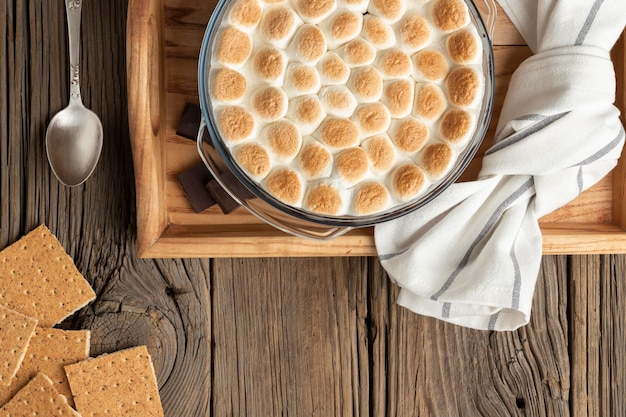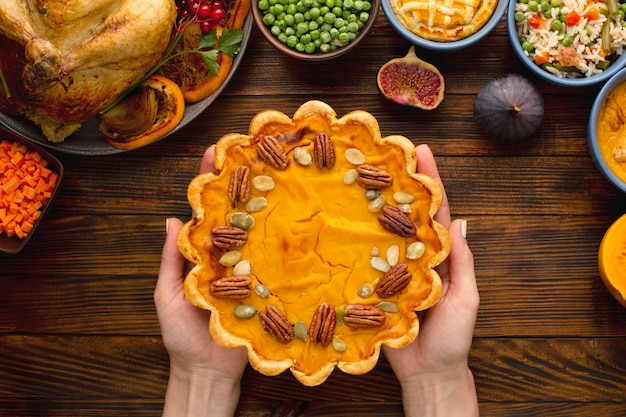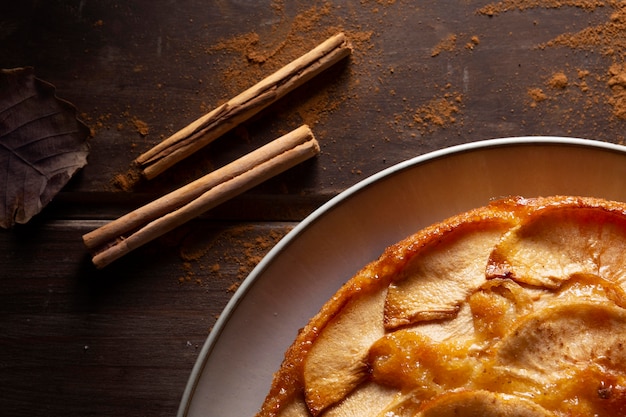I’ll admit it, I’m a bit of a sweet potato pie fanatic. There’s just something about that warm, spiced filling and the flaky crust that makes me weak in the knees. But the thing is, getting that pie just right can be a bit of a puzzle, especially when it comes to figuring out the perfect baking time. It’s a common question I get from fellow pie lovers: "How long do I cook this sweet potato pie?"
Well, fret no more, my friends! Today, we’re diving deep into the world of sweet potato pie baking time. We’ll talk about the science behind it, share some of my personal tips and tricks, and even explore a few variations that’ll have you dreaming up pie creations. Get ready to become a sweet potato pie pro!
(Part 1) Sweet Potato Pie: A Slice of History

Before we dive into the nitty-gritty of baking times, let’s take a little trip back in time to appreciate the history of this beloved dessert. Sweet potato pie, believe it or not, has a rich and fascinating past that’s deeply intertwined with the cultural heritage of the American South.
Native American Roots
sweet potatoes were cultivated by Native Americans long before European settlers arrived on the scene. They were a vital source of sustenance and were used in various ways, including in pies. These early versions of sweet potato pie were likely simpler, perhaps using only sweet potatoes, a little bit of honey, and maybe some spices.
Colonial Influence
During the colonial era, sweet potatoes were introduced to Europeans and quickly gained popularity. As settlers spread throughout the South, sweet potato pie became a staple in homes and kitchens. The use of spices like cinnamon, nutmeg, and ginger, which were common imports at the time, added another dimension to the pie's flavour profile.
Southern Tradition
By the 19th century, sweet potato pie had truly cemented its place as a beloved dessert in the South. It was a common sight at family gatherings, church events, and special occasions. The sweet potato, readily available and inexpensive, became a symbol of Southern hospitality and resourceful cooking.
Beyond the South
From its humble beginnings in the South, sweet potato pie has travelled far and wide. Today, it’s enjoyed by people all over the world, a testament to its universal appeal and deliciousness. It's a reminder that food has the power to transcend borders and connect people across cultures.
(Part 2) The Science Behind Baking Time

Now that we’ve journeyed through the history of sweet potato pie, it’s time to get down to the science behind baking time. This is where we unravel the mysteries of how long it takes to cook a pie to perfection.
Heat Transfer and the Pie Crust
The process of baking a sweet potato pie is all about heat transfer. The oven's heat penetrates the pie crust and the filling, causing the ingredients to cook and transform. The pie crust, usually made from flour, butter, and water, acts as a barrier, holding the filling together and creating a delicious outer layer.
Filling Thickness and Baking Time
The thickness of the sweet potato filling is one of the key factors influencing baking time. Think of it this way: the thicker the filling, the longer it takes for the heat to penetrate and cook the ingredients through. A thinner filling will cook faster because the heat can reach the centre more quickly.
Pie Pan Size: A Matter of Depth
The size and type of pie pan you choose also play a significant role. A standard 9-inch pie pan is shallower, meaning your pie will cook faster compared to a deeper 9-inch deep-dish pie pan. The thicker layer of filling in a deep-dish pan needs more time for the heat to reach the centre and set.
Other Factors to Consider
Aside from the pie pan and filling thickness, there are a few other factors that can affect baking time:
- Oven Temperature: A hotter oven will cook the pie faster. Always preheat your oven to 350°F (175°C) to ensure even cooking.
- Filling Ingredients: If your recipe calls for a lot of thickeners, like cornstarch or flour, it might take a little longer for the filling to set.
- Crust Type: A pre-made pie crust tends to be thinner and cooks faster than a homemade crust.
- Altitude: If you live at a higher altitude, your oven might cook a bit differently. You might need to adjust baking time slightly, keeping a close eye on the pie to ensure it doesn't overcook.
(Part 3) My Sweet Potato Pie Baking Time Secrets

Now, let’s get into the heart of it all: my personal experience and tips for baking a perfect sweet potato pie. Over the years, I’ve learned a few tricks that have helped me consistently achieve that perfect balance of gooey filling and flaky crust.
1. The Toothpick Test: Your Pie's Best Friend
My go-to method for checking if my sweet potato pie is done is the classic "toothpick test." After about 45 minutes of baking, I carefully insert a toothpick into the centre of the filling. If it comes out clean, or with just a few moist crumbs clinging to it, the pie is ready! If it comes out with wet filling, it needs a bit more time in the oven.
2. Don't Overdo It: Preventing a Dry Pie
Remember, the key is to bake your sweet potato pie just right. You don't want to overbake it, as this can dry out the filling and result in a hard crust. If the crust starts to brown too quickly, you can shield it by covering the edges with a strip of aluminum foil.
3. Cool Down Time: Patience is a Virtue
Once the pie is out of the oven, let it cool completely on a wire rack before serving. This allows the filling to set properly and the flavours to develop. It's a crucial step for achieving a smooth, sliceable pie. Believe me, a little patience goes a long way!
(Part 4) Baking Time Chart: Your Guide to Pie Perfection
To make your life a little easier, I’ve created a handy guide that breaks down the approximate baking times for different pie pan types and filling thicknesses:
| Pie Pan Type | Filling Thickness | Baking Time (Minutes) |
|---|---|---|
| Standard 9-inch Pie Pan | Thin | 45-55 |
| Standard 9-inch Pie Pan | Medium | 55-65 |
| Standard 9-inch Pie Pan | Thick | 65-75 |
| Deep-Dish 9-inch Pie Pan | Thin | 55-65 |
| Deep-Dish 9-inch Pie Pan | Medium | 65-75 |
| Deep-Dish 9-inch Pie Pan | Thick | 75-85 |
Always remember, these are just estimates. The toothpick test is your ultimate guide to determining if your pie is perfectly cooked.
(Part 5) Sweet Potato Pie: A Taste of Tradition
Sweet potato pie is much more than just a dessert; it’s a symbol of warmth, comfort, and tradition. It’s a taste of home, a connection to family, and a reminder of the simple pleasures in life. The aroma of cinnamon, nutmeg, and ginger fills the air, inviting you in and bringing back memories of holidays spent with loved ones. The first bite, rich and creamy, melts in your mouth, bringing a wave of nostalgia and happiness.
For me, baking a sweet potato pie is a deeply personal experience. Each time I bake one, I’m not just following a recipe; I’m creating a piece of my own story. It’s a story filled with memories, love, and tradition. It’s a way of sharing a part of myself with those I love, a way of bringing people together around a shared experience, a shared joy.
(Part 6) Beyond the Basics: Adding Your Own Flair
The beauty of sweet potato pie is its versatility. Don’t be afraid to experiment with different ingredients, flavours, and toppings. Add a pinch of orange zest for a citrusy twist, a sprinkle of chopped pecans for some added crunch, or a dollop of whipped cream for a decadent finish. Let your imagination run wild!
My Sweet Potato Pie Twists
Here are a few of my favourite twists on the classic sweet potato pie that I think you’ll enjoy:
- Chocolate Chip Sweet Potato Pie: For a touch of indulgence, add some chocolate chips to the filling before baking. The chocolate melts into the sweet potato filling, creating a decadent and irresistible treat.
- Spiced Rum Sweet Potato Pie: For a bolder flavour, try adding a tablespoon or two of spiced rum to the filling. The rum adds a complex depth to the flavour, making it a truly sophisticated dessert.
- Pumpkin Spice Sweet Potato Pie: Combine the best of both worlds by adding a tablespoon or two of pumpkin spice to the filling. The warm spices of pumpkin pie blend perfectly with the sweet potato, creating a unique and comforting flavour.
- Sweet Potato Pie with Marshmallow Topping: For a nostalgic touch, try topping your pie with a generous layer of toasted marshmallows. The gooey sweetness of the marshmallows complements the rich sweetness of the pie.
(Part 7) Sweet Potato Pie: More Than Just a Dessert
As we’ve explored, sweet potato pie is much more than just a delicious dessert. It's a cultural icon, a symbol of warmth, and a reminder of the power of food to bring people together. It’s a testament to the ingenuity and resourcefulness of our ancestors, a reminder of the importance of tradition, and a source of pure, unadulterated joy.
So, next time you’re craving something sweet, comforting, and special, don’t hesitate to whip up a batch of sweet potato pie. You’ll be surprised at how easy it is to create this delicious and nostalgic dessert.
(Part 8) FAQs: Your Sweet Potato Pie Questions Answered
Here are a few frequently asked questions about sweet potato pie, along with my expert answers:
1. How do I know if my sweet potato pie is done?
The best way to check if your pie is done is by using the toothpick test. Insert a toothpick into the centre of the filling. If it comes out clean, or with only a few moist crumbs clinging to it, the pie is ready! If it comes out with wet filling, it needs a little more time in the oven. You can also check the edges of the crust. If they are golden brown and slightly firm to the touch, the pie is likely done.
2. What happens if I overbake my sweet potato pie?
Overbaking your sweet potato pie can result in a dry, crumbly filling and a hard, brittle crust. The flavours can also become concentrated and less appealing. If you think you've overbaked your pie, don't worry! Try adding a little bit of milk or cream to the filling and stirring it gently. This can help to rehydrate the filling. You can also cover the pie with aluminum foil for a few minutes to prevent it from drying out further.
3. Can I freeze sweet potato pie?
Yes, you can definitely freeze sweet potato pie. It’s best to freeze the pie completely cooled. Wrap the pie tightly in plastic wrap, then place it in a freezer bag. Frozen sweet potato pie will last for up to 3 months. To thaw the pie, place it in the refrigerator overnight. To reheat, you can either bake it at 350°F (175°C) for about 15 minutes, or microwave it for a few minutes.
4. What kind of sweet potatoes should I use for pie?
You can use any type of sweet potato for pie, but some varieties are better suited for baking than others. Look for sweet potatoes that are firm, smooth, and free of blemishes. Avoid sweet potatoes that are soft or have wrinkles, as they may be past their prime. Some popular sweet potato varieties for pie include Garnet, Beauregard, and Jewel.
5. What are some tips for making a delicious sweet potato pie crust?
For a flaky, buttery crust, you can use a combination of cold butter and shortening. Make sure to keep the dough cold throughout the process, as this helps to prevent the crust from getting tough. You can also add a tablespoon or two of sugar to the dough for a sweeter crust. To prevent the crust from getting soggy, brush it with an egg wash before baking. This will help to create a golden brown and crispy crust.
So, there you have it! A comprehensive guide to baking the perfect sweet potato pie. I hope you find this information helpful. Remember, baking is a journey, so don’t be afraid to experiment and find your own sweet potato pie perfection. Happy baking, and may your pie be filled with warmth, joy, and deliciousness!
Everyone is watching

Prime Rib Roast Cooking Time Chart: Per Pound Guide
Cooking TipsPrime rib roast. Just the name conjures images of lavish dinners, crackling fires, and hearty laughter. It’s ...

How Long to Bake Potatoes in the Oven (Perfect Every Time)
Cooking TipsBaked potatoes are a staple in my kitchen. They're incredibly versatile, delicious, and surprisingly easy to m...

Perfect Rice Every Time: The Ultimate Guide to Cooking Rice
Cooking TipsAs a self-proclaimed foodie, I've always been a bit obsessed with rice. It's the foundation of countless cuisi...

The Ultimate Guide to Cooking Asparagus: Tips, Techniques, and Recipes
Cooking TipsAsparagus. The mere mention of this spring delicacy conjures up images of vibrant green spears, crisp and burs...

Ultimate Guide to Cooking the Perfect Thanksgiving Turkey
Cooking TipsThanksgiving. Just the word conjures up images of overflowing tables laden with delicious food, the scent of r...
